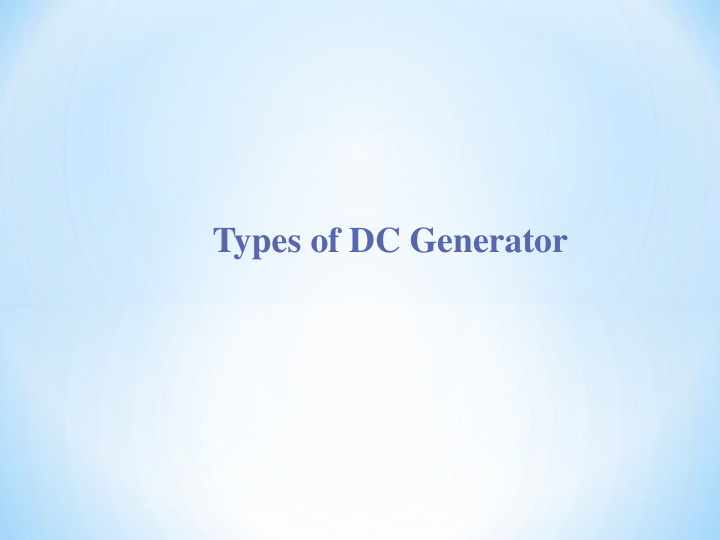



Types of DC Generator
2
Separately Excited DC Generator I a = Armature current I L = Load current V = Terminal voltage E g = Generated emf Voltage drop in the armature = I a × R a (R/sub>a is the armature Resistance) Let, I a = I L = I (say) Then, Voltage across the load, V = IR a 3 Power generated, P g = E g × I
Self Exited DC Generator These are the generators whose field magnets are energized by the current supplied by themselves. In these type of machines field coils are internally connected with the armature. Due to residual magnetism some flux is always present in the poles. When the armature is rotated some emf is induced. Hence some induced current is produced. This small current flows through the field coil as well as the load and thereby strengthening the pole flux. 4
As the pole flux strengthened, it will produce more armature emf, which cause further increase of current through the field. This increased field current further raises armature emf and this cumulative phenomenon continues until the excitation reaches to the rated value. 5
According To The Position Of The Field Coil DC Generator Has A Three Type 1) Series Generator 2) Shunt Generator 3) Compound Generator 6
Series Generator In these type of generators, the field windings are connected in series with armature conductors. So, whole current flows through the field coils as well as the load. As series field winding carries full load current it is designed with relatively few turns of thick wire. The Electrical resistance of series field winding is therefore very low (nearly 0.5 Ω ). 7
Let, R sc = Series winding resistance I sc = Current flowing through the series field R a = Armature Resistance I a = Armature current I L =Load current V = Terminal voltage E g = Generated emf Then, I a = I sc = I L =I (say) Voltage across the load, V = E g -I(I a × R a ) Power generated, P g = E g × I 8 Power delivered to the load, P L = V × I
Shunt Generator In these type of generators, the field windings are connected in Parallel with armature conductors. In shunt generators the voltage in the field winding is same as the voltage across the terminal. Here armature current I a is dividing in two parts, one is shunt field current I sh and another is load current I L . So, I a = I sh + I L The effective power across the load will be maximum when I L will be maximum. So, it is required to keep shunt field current as small as possible. For this purpose the resistance of the shunt field 9 winding generally kept high (100 Ω ) and large no of turns are used for the desired emf.
Let, R sh = Shunt winding Resistance I sh = Current flowing through the shunt field R a = Armature Resistance I a = Armature current I L = Load current V = Terminal voltage E g = Generated emf Shunt field current, I sh = V/R sh Voltage across the load, V = E g -I a R a Power generated, P g = E g × I a 1 o 0 wer delivered to the load, P = V × I P L L
Compound DC Generator In series wound generators, the output voltage is directly proportional with load current. In shunt wound generators, output voltage is inversely proportional with load current. A combination of these two types of generators can overcome the disadvantages of both. This combination of windings is called compound wound DC generator. Compound wound generators have both series field winding and shunt field winding. One winding is placed in series with the armature and the other is placed in parallel with the armature 1 . 1
Compound Generator Has A two Type 1) Short Shunt 2) Long shunt 12
Short Shunt DC compound Generator Series field current, I sc = I L Shunt field current, I sh = (V + I sc R sc )/R sh Armature current, I a = I sh + I L Voltage across the load, V = E g - I a R a - I sc R sc Power generated, P g = E g × I a 13 Power delivered to the load, P =V × I
Long Shunt Compound DC Generator Shunt field current, I sh =V/R sh Armature current, I a = series field current, I sc = I L + I sh Voltage across the load, V=E g -I a R a -I sc R sc =E g -I a (R a + R sc ) [ ∴ I a = I cs ] Power generated, P g = E g × I a 14 Power delivered to the load, P L =V × I L
In a compound generator, the shunt field is stronger than the series field. When the series field assists the shunt field, generator is said to be commutatively compound generator. On the other hand if series field opposes the shunt field, the generator is said to be differentially compound generator. 15
16
Recommend
More recommend